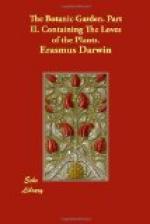270 Bore his pale fire, and led his lovely boy;
With loitering step the fair Creusa stay’d,
And Death involved her in eternal shade.—
Oft the lone Pilgrim that his road forsakes,
Marks the wide ruins, and the sulphur’d lakes;
275 On mouldering piles amid asphaltic mud
Hears the hoarse bittern, where Gomorrah stood;
Recalls the unhappy Pair with lifted eye,
Leans on the crystal tomb, and breathes the silent sigh..
With
net-wove sash and glittering gorget dress’d,
280 And scarlet robe lapell’d upon her breast,
Stern
ARA frowns, the measured march assumes,
Trails
her long lance, and nods her shadowy plumes;
[Arum. I. 281. Cuckow-pint, of the class Gynandria, or masculine ladies. The pistil, or female part of the flower, rises like a club, is covered above or clothed, as it were, by the anthers or males; and some of the species have a large scarlet blotch in the middle of every leaf.
The singular and wonderful structure of this flower has occasioned many disputes amongst botanists. See Tourniff. Malpig. Dillen. Rivin. &c. The receptacle is enlarged into a naked club, with the germs at its base; the stamens are affixed to the receptacle amidst the germs (a natural prodigy), and thus do not need the assistance of elevating filaments: hence the flower may be said to be inverted. Families of Plants translated from Linneus, p. 618.
The spadix of this plant is frequently quite white, or coloured, and the leaves liable to be streaked with white, and to have black or scarlet blotches on them. As the plant has no corol or blossom, it is probable the coloured juices in these parts of the sheath or leaves may serve the same purpose as the coloured juices in the petals of other flowers; from which I suppose the honey to be prepared. See note on Helleborus. I am informed that those tulip-roots which have a red cuticle produce red flowers. See Rubia.
When the petals of the tulip become striped with many colours, the plant loses almost half of its height; and the method of making them thus break into colours is by transplanting them into a meagre or sandy soil, after they have previously enjoyed a richer soil: hence it appears, that the plant is weakened when the flower becomes variegated. See note on Anemone. For the acquired habits of vegetables, see Tulipa, Orchis.
The roots of the Arum are scratched up and eaten by thrushes in severe snowy seasons. White’s Hist. of Selbourn, p. 43.]
While
Love’s soft beams illume her treacherous eyes,
And
Beauty lightens through the thin disguise.
285 So erst, when HERCULES, untamed by toil,
Own’d
the soft power of DEJANIRA’S smile;—
His
lion-spoils the laughing Fair demands,
And




